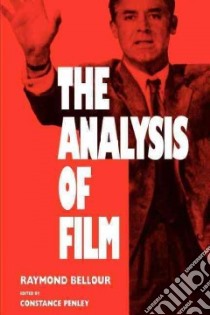- Libreria
- >
- Libri in lingua
- >
- Film theory & criticism
The Analysis of Film - 9780253213648
Un libro in lingua di Raymond Bellour Penley Constance (EDT) edito da Indiana Univ Pr, 2002
- € 26.40
- Il prezzo è variabile in funzione del cambio della valuta d’origine
"No serious student of film should miss the great work collected in this volume."—W. A. Vincent, Choice
"When so much writing about film is based on overall impressions or shadowy memories, on notes scribbled in the dark or published shot breakdowns that are often overgeneralized or even inaccurate, it is refreshing to be confronted with such scholarly work, characterized by a genuinely attentive eye and a punctilious observation of detail. This long-awaited collection, gathering Bellour's ground breaking studies into one volume, will surely be a crucial source of inspiration for future generations of film scholars." —Peter Wollen, Bookforum
The Analysis of Film brings together Raymonds Bellour's now classic studies of classic Hollywood film. It is at once a book about the methods of close film analysis, the narrative structure of Hollywood film, Hitchcock's work—The Birds, Marnie, Psycho, North by Northwest—and the role of the woman in western representation. But, finally, it is a book about cinema itself and the love for cinema that drives the passion for analyzing the supreme art form of the twentieth century.
Bellour creatively reworks the ideas and methods of structuralism, semiology, and psychoanalysis to unravel the knot of significations that is the filmic text. The introductory chapter sketches out a history of the way the close analysis of film developed. And then, beginning with a study of the Bodega Bay sequence of The Birds, the book goes on to examine every aspect of that singular critical practice, "the analysis of film."
The book is also a model of how to write about the intricacies of film narrative, shot by shot, sequence by sequence, while addressing larger contextual issues of subjectivity, desire, and identification in Western cultural forms. A new, final chapter on D. W. Griffith's The Lonedale Operator brilliantly demonstrates that the dynamics of repetition and alternation that Bellour discovered to be the heartbeat of Hollywood narrative film were already there in nascent form at the beginnings of cinema.
Informazioni bibliografiche
- Titolo del Libro in lingua: The Analysis of Film
- Lingua: English
- Autori : Raymond Bellour Penley Constance (EDT)
- Editore: Indiana Univ Pr
- Collana: Indiana Univ Pr (Paperback)
- Data di Pubblicazione: 01 Gennaio '02
- Genere: PERFORMING ARTS
- Argomenti : Motion pictures Production and direction Cinematography
- Pagine: 303
- Dimensioni mm: 234 x 158 x 19
- ISBN-10: 0253213649
- EAN-13: 9780253213648


